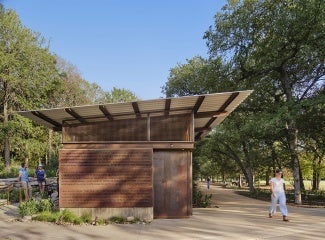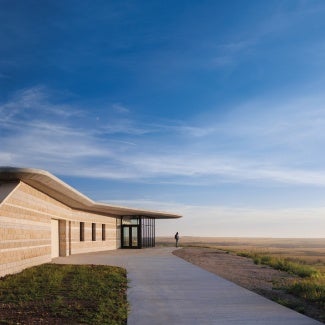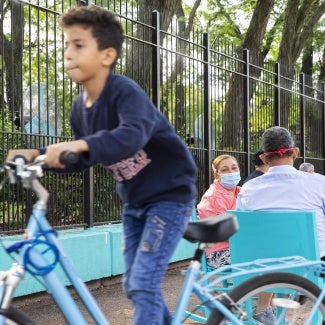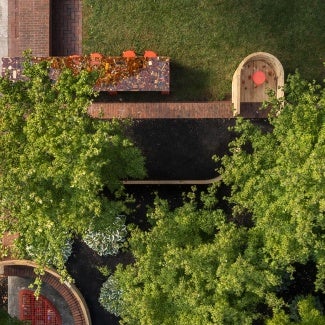Kingsbury Commons at Pease Park
The award-winning small project design of Kingsbury Commons at Pease Park in Austin, Texas, revitalizes the park’s southernmost tip and transforms an underused historic building into a thriving event space.
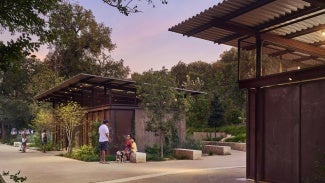
Project highlights: Kingsbury Commons at Pease Park
- Architecture firm: Clayton Korte
- Owner: Pease Park Conservancy
- Location: Austin, Texas
- Category: Two
- Project site: Previously developed
- Building program type(s): Public assembly - recreation
The 84-acre Pease Park, recognized as Austin’s first park, serves as a green retreat for residents as well as a buffer between downtown and the sprawling neighborhoods along the banks of Shoal Creek. This project is a critical component of the city’s plan for revitalizing the park’s southernmost tip and has transformed an underused historic building into a thriving event space that reinforces the park’s role in gathering people and connecting them to place.
The team’s design weaves together existing vegetation with a robust program of new amenities that include event rental spaces, restrooms, natural playgrounds, a basketball court, and an interactive water feature that cleverly references the Texas Hill Country’s karst limestone aquifers. Existing features, such as the Civilian Conservation Corps-era picnic tables and the park’s historic Tudor Cottage, were preserved to showcase the park’s rich history.
Originally built in the 1920s, the Tudor Cottage was among the first facility buildings constructed in this section of the park. From its spot on a bluff that overlooks the southern end of the park, the cottage originally functioned as a restroom. After renovation by the team, it is now a perfectly situated event space adjacent to other park activities. Inside, interior walls were removed to transform the space into a single room that is enhanced by the vaulted ceiling. A new glazed opening that faces north connects the space to a large terrace where visitors can look over the park.
Not far from the cottage on the park’s western edge, two new buildings, a restroom and storage building, are tucked into the slope of the hill and clad with steel mesh for ivy to climb along. The team selected a muted material palette of board-formed concrete and steel that will develop a striking patina with time. Additional amphitheater-style seating was built into the hillside, forming an ideal spot to organize volunteer workdays or for visitors to rest in the shade.
Tying the project together is a low ribbon-like limestone wall that unifies the numerous outdoor elements as it snakes through the park. Depending on the elevation, the wall steps up and down, alternating as seating, steps up the hillside, or a band that runs flush with the sidewalk. It also morphs into the water feature that attracts the park’s youngest visitors in the summer.
Framework for Design Excellence measures
Was there a design charrette? No
Level of community engagement:
Consult: Stakeholders were provided with opportunities to provide input at pre-designed points in the process.
Involve: Stakeholders were involved throughout most of the process.
Collaborate: A partnership is formed with stakeholders to share in the decision making process including development of alternatives and identification of the preferred solution.
Site area that supported vegetation (landscape or green roof) pre-development: Unknown
Site area that supports vegetation post-development: 95%
Site area covered by native plants supporting native or migratory species and pollinators: 95%
Strategies used to promote Design for Ecosystems: Biodiversity, Dark skies, Bird safety, Habitat conservation, flora/fauna, Abatement of specific regional environmental concerns
Is potable water used for irrigation? Yes
Is potable water used for cooling? No
Is grey/blackwater reused on-site? No
Is rainwater collected on-site? No
Stormwater managed on-site: 100 %
2030 Commitment baseline EUI: 72 kBtu/sf/yr
Predicted net EUI including on-site renewables: 0 kBtu/sf/yr
Reduction from the benchmark: Not applicable
Is the project all-electric? Yes
Level of air filters installed: Not applicable
Was a “chemicals of concern” list used to inform material selection? Unknown
Do greater than 90% of occupied spaces have a direct view to the outdoors? Yes
Were embodied carbon emissions estimated for this project? No
Estimated service life: 100 years
Floor area, if any, representing adapting existing buildings: 25%
Ability to survive without utility power: Passive survivability
Risk assessment and resilience services provided: None of the above
Has a post-occupancy evaluation been conducted? Yes
Building performance transparency steps taken:
Present the design, outcomes, and/or lessons learned to the office.
Present the design, outcomes, and/or lessons learned to the public.
Project team & jury
Year of substantial project completion: 2021
Gross conditioned floor area: 0 sq. ft.
Landscape Architect / Prime Consultant: Ten Eyck Landscape Architects
Engineer - Civil: Garza EMC
Engineer - MEP: Jerry Garza & Associates
Engineer - Structural: Architectural Engineers Collaborative
Lighting Designer: Studio Lumina
Graphics and Wayfinding: Page/Dyal
Water Feature: GPSI
General Contractor: Harvey-Cleary Builders
Chandra Robinson, AIA (Chair), LEVER Architecture, Portland, Ore.
Katherine Hogan, AIA, Katherine Hogan Architects, Raleigh, N.C.
Chris Baribeau, AIA, Modus Studio, Fayetteville, Ark.
David Corban, AIA, David Corban Architects, Naples, Fla.
Madhubala Ayyamperumal, Assoc. AIA, Gensler, San Francisco
AIA and its Small Project Design (SPD) Knowledge Community present the annual Small Project Award Program to raise public awareness of the value and design excellence that architects provide regardless of the limits of size and budget.
Nine projects showcase the best small project design and the big impact small projects can have on people and communities.

